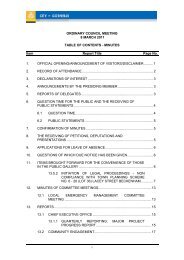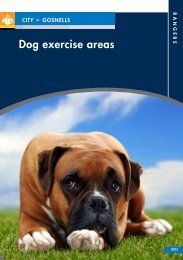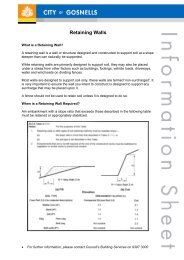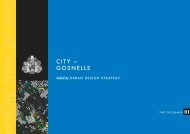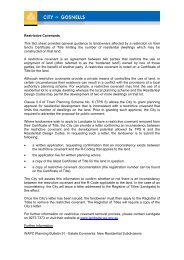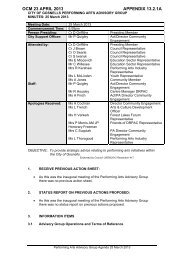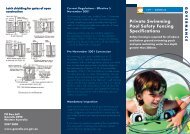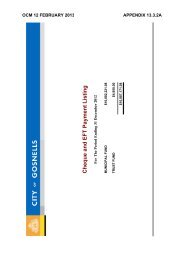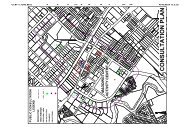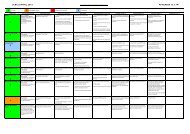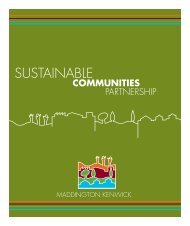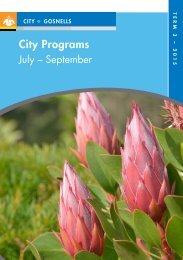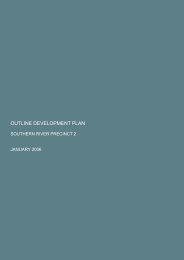Summary - City of Gosnells
Summary - City of Gosnells
Summary - City of Gosnells
You also want an ePaper? Increase the reach of your titles
YUMPU automatically turns print PDFs into web optimized ePapers that Google loves.
Introduction 3water drained from shallow groundwater aquifers by drains that intersect them would be exported out <strong>of</strong>the area via Yule Brook rather than being infiltrated at their source in Precinct 3.The current study reviewed the literature <strong>of</strong> the flora, vegetation and wetlands <strong>of</strong> the MKSEA and carried outdetailed field surveys (from spring 2007 to winter 2009) <strong>of</strong> the flora and vegetation in the area. It alsoground-truthed the geomorphic classifications, management categories and boundaries <strong>of</strong> the wetlandscurrently mapped in the DEC SCP Wetland Dataset within the MKSEA. It also investigated the bushlandremnants in the MKSEA and the proposed greenway links through the MKSEA that had been prioritised bythe Western Australian Local Government Association Perth Biodiversity Project (Figure 4). The fieldsurvey found a species-rich flora and numerous conservation values <strong>of</strong> national, state and regionalsignificance within the remnant wetlands and bushlands <strong>of</strong> the MKSEA. Some <strong>of</strong> the important values foundin the MKSEA in this survey are not currently represented in the conservation reserves <strong>of</strong> the area. A number<strong>of</strong> recommendations are provided to the <strong>City</strong> <strong>of</strong> <strong>Gosnells</strong> based on the findings <strong>of</strong> this survey.1.1 Project Scope and ObjectivesThe scope and objectives <strong>of</strong> the current flora, vegetation and wetlands survey are outlined in the <strong>City</strong> <strong>of</strong><strong>Gosnells</strong> brief <strong>of</strong> late August 2007 (<strong>City</strong> <strong>of</strong> <strong>Gosnells</strong>, 2007c).The current survey area is defined as the Maddington Kenwick Strategic Employment Area (MKSEA)(Figures 1, 2, 3), not including Bush Forever Sites 53 and 387 (with the exception <strong>of</strong> two discrete portions <strong>of</strong>Site 387 that are located on the south-eastern side <strong>of</strong> Boundary Rd). However, the survey brief states that“the context <strong>of</strong> the [MKSEA] area in the district, located between the Canning River and the Darling Rangefoothills, will need to be recognised”, a statement consistent with the intent <strong>of</strong> the WA Local GovernmentAssociation Perth Biodiversity Project (Del Marco et al., 2004) in envisioning greenway links through theMKSEA and the local Bush Forever Sites to improve the regional connectivity between areas <strong>of</strong> highconservation significance in the region (Figure 4). It also indicates that the task include an assessment <strong>of</strong> theconservation values within the MKSEA footprint and a description <strong>of</strong> the interaction between the wetlands <strong>of</strong>the study area and their surrounds.It was anticipated that some examination <strong>of</strong> areas surrounding the MKSEA (particularly <strong>of</strong> the Bush Foreversites) would also be required. This examination would be conducted largely at a desktop level as reliable data<strong>of</strong> the Bush Forever sites, especially BFS 387, were already available in the literature.1.1.1 Flora and Vegetation SurveyThe current flora and vegetation survey was required to be a Level 2 Detailed Flora and Vegetation Survey,as per EPA Guidance Statement No. 51 (EPA, 2004b), consisting <strong>of</strong> three or more stages. The specificobjectives <strong>of</strong> the survey that were specified in the brief were to:• Identify, describe and map each vegetation unit in the study area at a fine scale;• Assess and map vegetation condition;• Establish and sample permanent 10 m by 10 m quadrats adequate in number to provide samples sufficientfor assigning Floristic Community Types (FCTs) [after Gibson et al., 1994] to them with the help <strong>of</strong>PATN ® [multivariate] analyses;• Carry out the PATN analyses <strong>of</strong> the quadrat samples and interpret the results <strong>of</strong> the analyses;• Identify and delineate Threatened Ecological Communities (TECs);• Search for Declared Rare Flora (DRF) and other significant taxa at appropriate times (generally duringspring and summer);• Compile one or more lists <strong>of</strong> flora recorded during the vegetation surveys and the searches for significantflora;Tauss, C. and Weston, A.S. (2010). The flora, vegetation and wetlands <strong>of</strong> the Maddington-Kenwick Strategic Employment Area.A survey <strong>of</strong> the rural lands in the vicinity <strong>of</strong> the Greater Brixton Street Wetlands. Report to the <strong>City</strong> <strong>of</strong> <strong>Gosnells</strong>, W.A. Version 18.04.10



